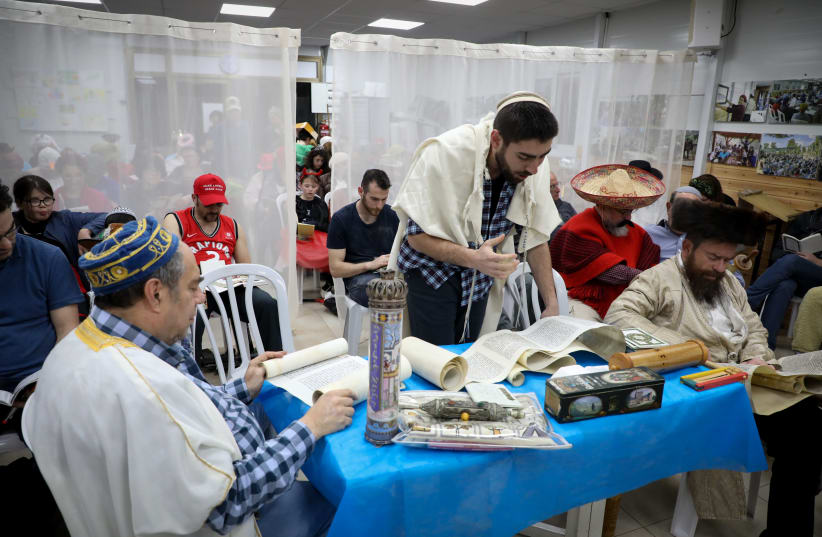As such, many have suggested utilizing microphones or Zoom, raising questions over the propriety of using these technologies for mitzvah performance.
All adult Jews are obligated to read Megilat Esther. When necessary, one can read it to one’s self, but most hear the Megillah in a public setting that helps publicize the miracle. The sages asserted that “listening is like speaking,” i.e., we legally deem a person to have read each word if they have heard each word. Accordingly, much emphasis is placed on creating optimal settings to maximize the ability for all attendees to concentrate on the Megillah chanting. Listeners should follow along carefully so that if they miss a few words, they can fill in the gaps by quickly reciting it to themselves and then resume their careful listening. (When possible, one should utilize a proper Megillah scroll to read along with the chanter, but otherwise, a printed Book of Esther is fine). For this reason, the excessive noisemaking from groggers is problematic, according to Jewish law, and should be avoided. Many communities offer multiple Megillah readings to help reduce noisy overcrowding in synagogues.
Nonetheless, in large crowds with little children, it can become difficult to hear the Megillah reading. In the first half of the 20th century, some suggested utilizing microphones to augment the sound of the reader. Despite the potential benefits, many legal decisors, including Rabbis Benzion Uziel and Shlomo Zalman Auerbach, opposed this proposal. The Talmud declares that on Rosh Hashanah, it is problematic to hear a shofar sound blown into a pit since one hears an echo and not the direct sound. Some argued that the same problem exists with a microphone, since one hears an analogue or digital reproduction of the original sound.
Alternatively, they contend that hearing in an abnormal fashion does not fulfill the requirements of listening. As such, they asserted that one cannot fulfill the mitzvah of Megillah reading through a microphone or a live radio broadcast. For the same reasons, some argued that one should not even answer “amen” to a blessing recited over the radio since one is not, for legal purposes, hearing the recitation of the blessing.
According to this logic, one could even assert that someone wearing hearing aids should remove them before shofar blowing or Megillah reading since they function in the same way as a microphone. Others, including Rabbi Moshe Sternbuch, countered that microphones are problematic because that is not the normal way in which someone hears sounds. In contrast, for those who wear hearing aids, this is their regular mechanism of listening and therefore they may listen through their aids or cochlear implants.
OVER THE decades, the dominant position in rabbinic circles prohibited using microphones for Megillah readings. Nonetheless, a minority strand of prominent decisors asserted that amplification systems could be utilized for rituals. For example, Rabbi Abraham Isaac Kook asserted that one may answer blessings recited over a microphone. Similarly, Rabbi Moshe Feinstein contended that you could recite havdalah over the phone for someone who could not do it themselves, such as for a family member in a nursing home.
More fundamentally, he and others asserted that the analogy to the shofar is inappropriate because the mitzvah of shofar performance is uniquely an auditory action, thereby placing unique restrictions on its performance. In contrast, the Megillah is supposed to be heard live in a way in which you attentively affirm those words. As long as you hear the sounds live and from the direct actions of the speaker, this works, even if the sound waves are transformed along the way. This was the conclusion of Rabbi Avraham Karelitz and, in particular, Rabbi Tzvi Pesach Frank, who permitted Megillah reading through a microphone.
Theoretically, Rabbi Feinstein also agreed regarding Megillah readings, but suggested that this new method should only be utilized when absolutely necessary. Rabbi Eliezer Waldenburg also sided with the stringent position but nonetheless agreed that it could be utilized in difficult circumstances (sha’at dechak in Hebrew).
While adopting the stringent position, Rabbi Ovadia Yosef contended that if the Megillah chanter could be heard anyway without the microphone, then one can place the microphone a short distance from the chanter and utilize it just to amplify the sound for those standing far away. This may be particularly useful for those reading in outdoor or courtyard services.
Unquestionably, the coronavirus has created many challenging circumstances for Megillah readings. While it is preferable to arrange small or private readings for all community members, this is frequently not feasible. Therefore, Rabbi Herschel Schachter and Rabbi Yosef Tzvi Rimon have ruled that one can utilize Zoom, if necessary, to fulfill the requirement of Megillah reading. Some decisors, including Rabbi Re’em Hacohen of Otniel, have noted that in many ways, a conference call might be more effective, since it is less likely to be interrupted because of Internet problems. Nonetheless, if necessary, one can utilize live Zoom readings. All efforts should be made to ensure beforehand that the Internet connection is strong. Moreover, I strongly recommend to carefully follow the reading with a personal copy of the Book of Esther so you can fill in any short gaps in the reading.
Purim sameach!
The writer is co-dean of the Tikvah Online Academy and a post-doctoral fellow at Bar-Ilan University Law School. His book, A Guide to the Complex: Contemporary Halakhic Debates, received a National Jewish Book Award.
